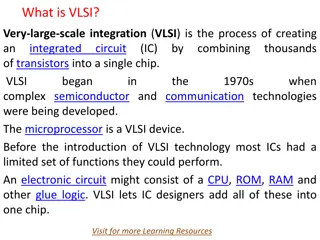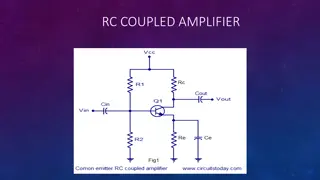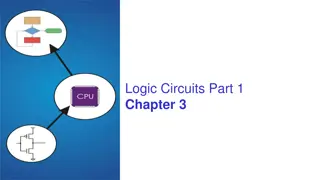Logic Families
Logic families such as Diode Logic (DL), Resistor-Transistor Logic (RTL), and Diode-Transistor Logic (DTL) each have distinct capabilities and limitations when it comes to performing logic functions. While DL gates are simple and inexpensive but limited in functionality, RTL gates offer both normal
1 views • 22 slides
Understanding VLSI Technology and Its Advantages
Very Large Scale Integration (VLSI) is the process of integrating hundreds of thousands of transistors onto a single microchip, revolutionizing the design and performance of electronic circuits. VLSI offers numerous advantages such as reduced circuit size, cost-effectiveness, increased operating spe
0 views • 15 slides
Evolution of Computers: Generations Overview
The evolution of computers through generations - from vacuum tubes and magnetic drums in the first generation to transistors and integrated circuits in later generations. Each phase brought advancements in size, speed, and efficiency, shaping the modern computing landscape.
0 views • 10 slides
Understanding Voltage Divider Biasing in Transistors
Study how to bias a transistor for linear operation using a resistive voltage divider connected to a single source. Learn the design principles, loading effects, stability considerations, and how to calculate key parameters for a successful voltage divider bias circuit.
0 views • 9 slides
Understanding the Differences and Characteristics of BJT and FET in Electronics
Learn about the disparities between Bipolar Junction Transistors (BJT) and Field-Effect Transistors (FET) in this informative content. Explore the construction, operation, and characteristics of these semiconductor devices, including N-channel JFET specifics, operating behaviors such as pinch-off, d
2 views • 9 slides
Understanding Integrated Circuit Amplifiers and Design Philosophy
Integrated Circuit (IC) amplifiers are essential components in modern electronics, consisting of miniaturized active and passive devices on a semiconductor substrate. This article explores the building blocks, design philosophy, terminology, device variety, and biasing of ICs, emphasizing the use of
0 views • 11 slides
Understanding the Two-Transistor Model of SCR for Beginners
Explore the two-transistor analogy of SCR, a method illustrating SCR as a combination of PNP and NPN transistors. Discover how the working principle is easily explained through this model, showcasing the transition from off to on state when triggering the SCR. Uncover the accumulative action of curr
0 views • 8 slides
Understanding Bipolar Transistor Configurations for Electronic Circuits
Explore the three common configurations - Common Base, Common Emitter, and Common Collector - for Bipolar Transistors in electronic circuits. Each configuration offers unique characteristics such as voltage gain, current gain, and impedance levels, impacting the signal processing and amplification c
0 views • 27 slides
Efficient Class B Amplifier Operation and Power Calculation
Class B amplifiers offer greater efficiency compared to single transistor Class A operation. This article covers the push-pull operation of Class B transistors, input DC power calculations, connecting push-pull amplifiers to loads, output AC power measurement, efficiency calculation, and power dissi
0 views • 28 slides
Evolution of Computers: From Vacuum Tubes to Transistors
The evolution of computers has seen remarkable progress from the era of vacuum tube machines to the introduction of transistors. Starting from massive devices to compact and powerful systems, computers have become an indispensable part of modern life. Explore the generations of computers, their func
0 views • 22 slides
Evolution of Semiconductor Devices in Modern Electronics
The lecture discusses the fundamentals of semiconductor drift and diffusion currents, diode behavior, transistor characteristics, and amplifier circuits in ECE 255. It explores the origins of modern electronics, from the invention of the bipolar transistor to the evolution of electronic devices thro
0 views • 35 slides
Understanding Field Effect Transistor (FET) and MOSFET Principles
Explore the construction, principles, characteristics, and relationships among parameters of Junction Field Effect Transistors (JFET) through detailed explanations and diagrams. Dive into the equation of drain characteristics and the resemblance to a parabolic curve. Understand the differentiation p
0 views • 9 slides
Understanding RC Coupled Amplifiers and Transistor Basics
Amplification is the process of increasing signal strength without changing its characteristics. An RC coupled amplifier is a multistage amplifier using resistors and capacitors. Transistor amplifiers amplify signals based on transistors with different configurations. The common emitter configuratio
0 views • 23 slides
Understanding Noise in RF Integrated Circuits: Thermal and 1/f Noise
Noise, an unwanted input, limits a system's ability to process weak signals. Sources of noise include random noise in resistors and transistors, mixer noise, undesired cross-coupling noise, and power supply noise. Thermal noise, caused by thermal agitation of charge carriers, is also known as Johnso
1 views • 49 slides
Power Electronics Market: Emerging Trends in Aerospace & Defense Applications
Power Electronics Market Size, Share, Forecast, & Trends Analysis by Type (Power ICs, Modules, Transistors, Thyristors, Regulators, Others), Application (Generation, Transmission, Distribution, Control), End-use Industry (Automotive, Consumer Electro
0 views • 3 slides
Clemson ECE Laboratories - Electronics Lab Information
Explore pre-labs for ECE 311 Electronics Lab I, created by Steven Chambers in Fall 2012 at Clemson University. The labs cover topics like curve tracer plots for diodes and transistors, background on Bipolar Junction Transistors (BJTs), instructor and lab coordinator contact information, mandatory sa
0 views • 69 slides
Understanding Operational Amplifiers (Op-Amps) and Their Applications
Operational Amplifiers (Op-Amps) are devices used to amplify signals using an external power source. They are composed of transistors, resistors, and capacitors. Op-Amps find applications in summing amplifiers, AC and DC signal processing, digital-to-analog converters, active filters, oscillators, r
1 views • 41 slides
Understanding Logic Circuits and Transistors in Computer Systems
Exploring the fundamentals of logic circuits in computer systems, this content delves into representing data at the electronic level, the role of transistors as building blocks, and the operation of simple switch circuits. It also discusses n-type and p-type MOS transistors, highlighting their funct
0 views • 43 slides
Emerging Materials for MOS-Transistor Gate Stacks in Semiconductor Technology
Advancements in semiconductor technology necessitate the adoption of new materials for gate stacks in MOS-transistors, addressing issues like gate leakage current and gate oxide problems. With the continual scaling down of MOSFETs, the use of high-K materials offers solutions to enhance performance
0 views • 51 slides
Understanding Flash Chips: Storage on NAND-Flash Devices
Flash chips, also known as SSDs, are designed to store bits in transistors, offering fast random access due to the absence of moving parts. Organized into banks, flash chips operate through read, erase, and program operations, each crucial for data storage and retrieval.
0 views • 39 slides
Exploring Nanofabrication: Revolutionizing Technology at the Nano Scale
Nanofabrication is a cutting-edge technology that manipulates materials on a minuscule scale, smaller than 100 nm. This process enables the creation of intricate structures like semiconductor chips, lab-on-a-chip devices, and mimicking natural nanostructures. With examples like the Apple A7 chip con
0 views • 11 slides
Understanding Fabrication Variability in Semiconductor Manufacturing
Fabrication variability in semiconductor manufacturing refers to variations in physical characteristics of transistors, impacting their electrical parameters. This variability, whether systematic or random, can lead to performance deviations in digital circuits, affecting power consumption, timing,
0 views • 48 slides
Understanding Basic Logic Gates in Digital Electronics
Explore the fundamentals of digital electronics through the study of AND, OR, and NOT gates, their Boolean expressions, truth tables, and circuit realizations using diodes and transistors. Discover how NAND and NOR gates serve as universal gates, enabling complex logic operations. Dive into the prin
0 views • 11 slides
Analogue Electronics Course Overview at University of Diyala - Hayder Khaleel AL-Qaysi
Explore the comprehensive syllabus of the Analogue Electronics course offered in the Department of Electronic Engineering at University of Diyala. Lectured by Hayder Khaleel AL-Qaysi, topics covered include Introduction to Electronics, Diodes, Bipolar Junction Transistors (BJTs), Power Amplifiers, a
0 views • 8 slides
DEPFET Internal Amplification vs. Oxide Thickness Simulation Study by Rainer Richter
The study explores the behavior of DEPFET internal amplification in comparison to oxide thickness through simulations conducted by Rainer Richter at the MPG Halbleiterlabor workshop. It delves into the differences in behavior between DEPFET and classical MOS transistors, shedding light on the reason
0 views • 11 slides
Understanding MOSFET Operation and Beyond in Electronic Devices
Explore the intricacies of MOSFET operation, from the basics of channel charge to pinch-off points and beyond. Delve into the saturation region, overdrive voltage, and the unique characteristics of MOSFETs compared to bipolar transistors. Gain insights into channel length modulation effects and the
0 views • 10 slides
Understanding NMOS Transistors in CMOS Logic Circuits
Explore the operation of NMOS transistors in CMOS logic circuits, learn about doping silicon for semi-conductance, and discover how gate voltages affect the behavior of NMOS transistors at different levels of activation. Dive into the intricacies of MOS transistors, CMOS inverters, and logic familie
0 views • 20 slides
Understanding Oscillators in Electronics
Explore the world of oscillators in electronics, including the operation of transistors in class-B and class-C amplifiers, the significance of achieving maximum swing, the theoretical efficiency of different amplifier classes, and the role of oscillators as signal generators in electronic circuits.
0 views • 20 slides
Evolution of Amplifiers: From WWII to Modern Integrated Circuits
Amplifiers have come a long way since their invention during WWII for mathematical operations. The modern amplifier is compact, high-performing, and integrated with transistors, resistors, and capacitors on a single chip. The properties of operation amplifiers, input modes, and differential inputs a
0 views • 10 slides
Exploring Electronic Alarm Circuits and Devices
Discover the workings of various electronic alarm circuits such as Frost Alarm, Fire Alarm, and Burglar Alarm. Learn how different sensors and components like thermistors, resistors, transistors, and capacitors are utilized to trigger alarms based on temperature changes, light conditions, and time d
0 views • 23 slides
Revolutionizing Electronics with Graphene-Based Transistors: A Game-Changer in Semiconductor Industry
Graphene, a single atom thick layer of carbon, holds immense potential in transforming the semiconductor industry. With exceptional properties such as high electron mobility, thermal and electrical conductivity, and strength, graphene offers a promising solution to the limitations faced by silicon t
0 views • 18 slides
Understanding How Computers Work: A Quick Overview
Computers process binary numbers to perform operations like addition, subtraction, multiplication, division, logical operations, and comparisons. This lecture provides an insight into the abstraction of computer components as black boxes by computer scientists, inspired by structured computer organi
0 views • 22 slides



























